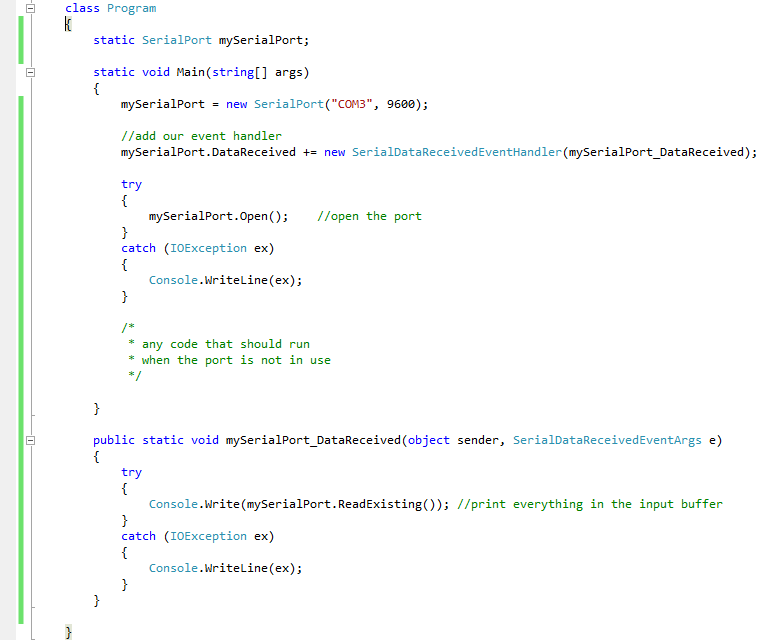

So at the time, this was an easy solution. NET serial port controls had not yet been written. NET was introduced to the world, and other. The article was (originally) written soon after. Now every week I get several e-mails with people asking questions and it is high time for some serious updating. It became quite popular and is (currently) the top Google search for "serial c#". NETīack in my early (pre C# MVP) days, I had written an article on DevHood titled Serial COM Simply in C#. This should work with any Arduino.SerialPort (RS-232 Serial COM Port) in C#. That should be all you need to get started with the basics of connecting and sending/receiving data to/from the Arduino on the serial ports. NET application now knows that it’s talking to our Arduino. If this equals ‘t’ then we respond with an OK string. We do this by reading the Serial data in the Loop, whilst the Serial is available.

My.(comPort)Īrduino Sketch (Checking the serial data for an incoming byte)Īnd in the Arduino sketch, respond to a certain string. The comPort variable is filled in by using the above auto connect code, you can run this on the Form_Load event: Sub sendCommand(data As String) We have written a basic function to open a COM port, send a string and close it again.
#Visual basic serial port datareceived event code
The code above also shows that we are wrapping this in a Try/Catch statement, this is because we’re trying to send data to all COM ports and we may receive an error message otherwise. (Note this would only work with 1 connected Arduino, extra programming would be required for multiple devices) If it’s “OK” then we set a global variable comPort and connected, so that we can use them elsewhere in the program. If the response equals “OK” we know this COM port has our Arduino connected. You can see this method with the following piece of code (VB.NET): For Each p As String In My.Īs you can see above, we loop through the list of available COM ports on the system and then try and send a string “t” to the Arduino and check for a response. (as seen below) This involves sending a byte to each of the COM ports and checking the response, in your Arduino sketch you can set it to respond to a certain string – If it matches this in VB.NET when you read the COM port then you have the right connection. You can either place this list of COM ports in a ListBox, or even better, configure your project to ‘auto’ connect to a COM port. Now that you have a basic application to work with, take a look at the following piece of code: For Each p As String In My.Īs you can see, you can get a list of available COM ports on the system, this is useful as the user does not have to select the correct COM port. We have named ours COMTest and saved it to the Desktop folder.

We are using Visual Studio 2015 for this tutorial, load it up and create a new project. You can easily and quickly use VB.NET to send and receive information from the serial COM port that your Arduino uses. One of the main features you can add to your Arduino, is communicating with it via an application.


 0 kommentar(er)
0 kommentar(er)
